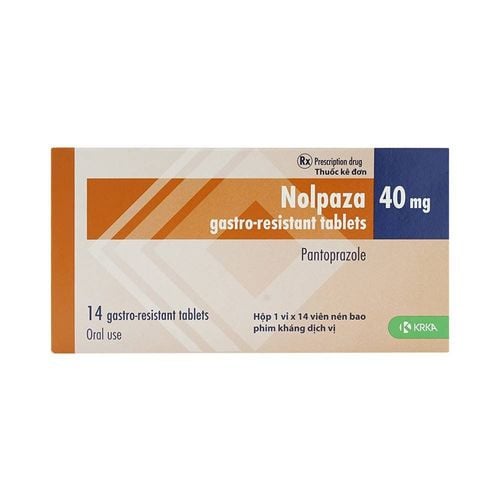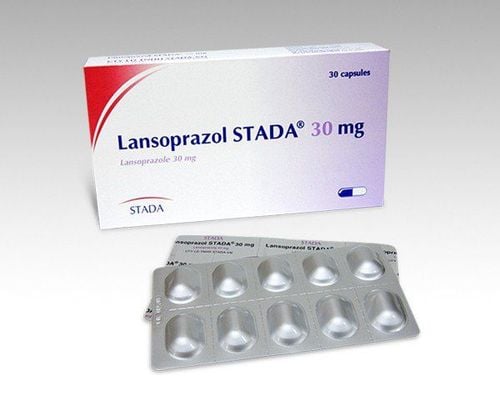This is an automatically translated article.
Gastroesophageal reflux really makes patients uncomfortable, Antaloc drug is one of the reasonable options for patients with this disease. So what is Antaloc? What does Antaloc do? What is the correct way to drink? What are the points to pay attention to when using? The following article will help you better understand the uses of Antaloc.
1. What are the uses of Antaloc?
1.1. What is Antaloc? Antaloc 40mg drug, a product of the manufacturer Boston Pharma, helps effectively treat gastric reflux, esophagitis, gastric and duodenal ulcers, Zollinger - Ellison syndrome and many other related conditions. indicated to help definitively treat the disease encountered.
Main ingredients of Antaloc drug: Pantoprazol sodium sesquihydrate equivalent to Pantoprazol 40mg.
Excipients: Mannitol, sodium carbonate, crospovidone, sodium lauryl sulfate, povidone K30, magnesium stearate, opadry AMB white, eudragit L100, triacetin, yellow iron oxide, talc powder just enough for 1 enteric coated tablet.
1.2. What does Antaloc do? Effects of Antaloc: Pantoprazole is a derivative of Benzimidazol, after entering the body, it is converted into an active form that inhibits the Proton pump (Na + - K + - ATPase) in gastric parietal cells. Acid secretion helps fight stomach ulcers. The degree of inhibition more or less depends on the dose of the drug.
Antaloc is used in:
Support treatment for patients with peptic ulcer disease. Relieves moderate to severe acid reflux. Combination therapy with antibiotics against stomach ulcers caused by H.Pylori infection. Improve symptoms for patients with Zollinger-Ellison syndrome.
2. How to use Antaloc?
2.1. How to take Antaloc The drug is taken orally. Once a day in the morning, before or after a meal, swallow the tablet whole, do not crush or chew the tablet.
2.2. Dosage of Antaloc Pantoprazol is used as a sodium salt, 11.28 mg pantoprazol sodium is equivalent to 10 mg pantoprazol.
Treatment of gastroesophageal reflux disease: Take once daily 20-40 mg in the morning for 4 weeks, can be increased to 8 or 16 weeks (if needed). Maintenance therapy with a dose of 20-40mg, should not be used for more than one year.
Treatment of benign gastric ulcer: Take 40 mg once a day, for 4 - 8 weeks.
Duodenal ulcer: Take 40 mg once a day, for 2-4 weeks.
To eradicate Helicobacter pylori, it is necessary to combine pantoprazol with 2 antibiotics in a 3-drug regimen, for 1 week. An effective regimen consists of oral pantoprazole 40 mg twice daily (morning and evening) + clarithromycin 500 mg twice daily + amoxicillin 1000 mg twice daily or metronidazole 400 mg twice daily. Or use pantoprazol 40 mg twice daily + clarithromycin 250 mg twice daily + metronidazole 400 mg twice daily.
Prophylaxis of peptic ulcers caused by non-steroidal anti-inflammatory drugs: 20 mg once daily.
Treatment of pathological hypersecretory conditions in Zollinger-Ellison syndrome: Initial dose of 80 mg once daily, then adjusted according to the patient's response (the maximum dose of 40 mg/day in the elderly) . The dose may be increased to 240 mg per day. If the daily dose is greater than 80 mg, then divided into 2 times a day.
Note: The above dosage is for reference only. The specific dose depends on the condition and the progression of the disease. To get the right dose, you need to consult your doctor or healthcare professional.
Handling missed dose: If you miss a dose, take it as soon as possible. However, if it is almost time for your next dose, skip the missed dose and take your next dose at the scheduled time. Note that double the prescribed dose should not be taken.
Treatment of overdose: Symptoms:
Signs and symptoms of overdose may be: Slightly tachycardia, vasodilation, somnolence, confusion, headache, blurred vision, abdominal pain, nausea and vomiting. vomit.
Treatment:
Gastric lavage, activated charcoal, symptomatic and supportive treatment. Monitor heart rate and blood pressure. If vomiting persists, monitor fluid and electrolyte status.
3. Contraindications of the drug Antaloc
Patients please do not use Antaloc 40mg in cases of hypersensitivity to any of the ingredients in the drug.
Do not use combination therapy with antiretroviral drugs Atazanavir.
Contraindicated in patients with moderate to severe liver and kidney dysfunction.
Although pantoprazole is metabolized by the cytochrome P450 enzyme system. In the liver, but does not inhibit or activate this enzyme system. No clinically significant interactions were observed between pantoprazol and commonly used drugs such as diazepam, phenytoin, nifedipine, theophylline, digoxin, warfarin or oral contraceptives. Like other proton pump inhibitors, pantoprazole can reduce the absorption of some drugs whose absorption is dependent on gastric pH, such as ketoconazole, itraconazole. Severe muscle pain and bone pain may occur when methotrexate is taken with pantoprazole.
4. Notes when using Antaloc drug
4.1. Precautions for use Before using pantoprazole as well as other proton pump inhibitors for gastric ulcers, the possibility of gastric cancer must be excluded because the drug may mask symptoms or will delay the diagnosis of cancer. .
Pantoprazole should be used with caution in patients with liver disease (acute, chronic or pre-existing). Serum concentrations of the drug may be slightly increased and elimination may be slightly reduced; but no dose adjustment is required. Avoid use in cirrhosis, or severe liver failure. If used, the dose must be reduced or given once a day. Liver function should be monitored regularly.
Use with caution in people with kidney failure, the elderly.
4.2. Ability to drive and use machines Caution should be exercised when taking the drug.
4.3. Pregnancy There is limited clinical experience with the use of the drug in women during pregnancy.
Use the drug only when the benefit to the mother outweighs the risk to the fetus.
4.4. Lactation There is no information on the excretion of the drug into breast milk.
Use the drug only when the benefit to the mother outweighs the risk to the nursing infant.
5. Antaloc drug side effects
Besides the effects of the drug, patients treated with Antaloc may also experience some unwanted effects:
Common unwanted effects: headache, fatigue, dizziness, hangover , vomiting, heat, high body temperature, constipation, diarrhea, vision disturbance, increased liver enzyme index. Uncommon side effects: allergic reactions, hypersensitivity, edema, anaphylaxis, myalgia, disturbances in consciousness, confusion, disorientation, depression. Rare side effects: decreased platelet and white blood cell counts, interstitial - tubular nephritis, hepatocellular damage. Patients should immediately notify the consulting pharmacist or treating doctor when seeing any abnormal signs during the use of the drug for timely and accurate treatment, avoiding bad cases.
6. How to store Antaloc?
Store in a cool, dry place, at a temperature not exceeding 30°C, in the original packaging and protected from light. Keep out of reach of CHILDREN. Do not use expired medicine for any reason.
Please dial HOTLINE for more information or register for an appointment HERE. Download MyVinmec app to make appointments faster and to manage your bookings easily.













